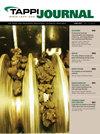使用漂白阶段模型对软木ECF漂白厂进行基准测试
IF 0.6
4区 农林科学
Q4 MATERIALS SCIENCE, PAPER & WOOD
引用次数: 0
摘要
使用稳态漂白脱木素和增亮模型来衡量无元素氯(ECF)漂白厂使用二氧化氯漂白25 kappa软木棕浆的效果。案例1检查了磨机1的五阶段序列的D0(EOP)D1部分,该序列使纸浆增亮至86%ISO。案例2研究了2号磨的四阶段序列中的D0(EO)D1部分,该部分使纸浆增亮至82%的ISO,案例3在同一漂白厂在提取阶段进行改进几年后重新检查了该漂白厂。模型强调了之前提到的漂白剂使用量高的情况下的天数,可能是因为高棕色库存和/或萃取清洗机携带,以及漂白剂使用正常的天数。在案例2中,该模型估计,漂白过程中消耗的44公斤二氧化氯/公吨纸浆中有10公斤可能与洗衣机结垢源发生反应;假定该额外消耗的大约三分之二与提取滤液反应。2号磨机所做的改变(案例3)将非生产性二氧化氯的使用量从10公斤/公吨纸浆减少到5公斤/公吨。当同时求解脱木素和增亮模型时,这些模型预测了二氧化氯在D0和D1中的优化分布与漂白厂中使用的实际值有些不同。然而,当考虑到洗衣机携带物来源时,预测的二氧化氯总量与实际值一致。这项研究表明,漂白模型可以作为软木ECF漂白植物的假设基准。本文章由计算机程序翻译,如有差异,请以英文原文为准。
Using bleaching stage models for benchmarking softwood ECF bleach plants
Steady-state bleaching delignification and brightening models were used to gauge how well elemental chlorine-free (ECF) bleach plants were using chlorine dioxide to bleach 25-kappa softwood brownstocks.
Case 1 examined the D0(EOP)D1 portion of Mill 1’s five-stage sequence that brightens the pulp to 86% ISO. Case 2 studied the D0(EO)D1 portion of Mill 2’s four-stage sequence, which brightens the pulp to 82% ISO, and Case 3 re-examined the same bleach plant several years after it made improvements around the extraction stage. The models highlighted days in the previously mentioned cases where high bleach usage occurred, presumably because of high brownstock and/or extraction washer carryover, and days where bleach usage was normal. In Case 2, the model estimated that 10 kg of the 44 kg chlorine dioxide/metric ton pulp consumed in bleaching was likely reacting with washer carryover sources; approximately two-thirds of this extra consumption was assumed to be reacting with extraction filtrate. Changes that Mill 2 made (Case 3) reduced the unproductive chlorine dioxide usage from 10 to 5 kg/metric ton pulp. When the delignification and brightening models were simultaneously solved, the models predicted somewhat different optimized distributions of chlorine dioxide to D0 and D1 vs. actual values used in bleach plants. However, the forecasted chlorine dioxide totals agreed with the actual values when washer carryover sources were considered. This study showed the bleaching models could be used as hypothetical benchmarks for softwood ECF bleach plants.
求助全文
通过发布文献求助,成功后即可免费获取论文全文。
去求助
来源期刊

Tappi Journal
工程技术-材料科学:纸与木材
CiteScore
1.30
自引率
16.70%
发文量
59
审稿时长
6-12 weeks
期刊介绍:
An internationally recognized technical publication for over 60 years, TAPPI Journal (TJ) publishes the latest and most relevant research on the forest products and related industries. A stringent peer-review process and distinguished editorial board of academic and industry experts set TAPPI Journal apart as a reliable source for impactful basic and applied research and technical reviews.
Available at no charge to TAPPI members, each issue of TAPPI Journal features research in pulp, paper, packaging, tissue, nonwovens, converting, bioenergy, nanotechnology or other innovative cellulosic-based products and technologies. Publishing in TAPPI Journal delivers your research to a global audience of colleagues, peers and employers.
 求助内容:
求助内容: 应助结果提醒方式:
应助结果提醒方式:


